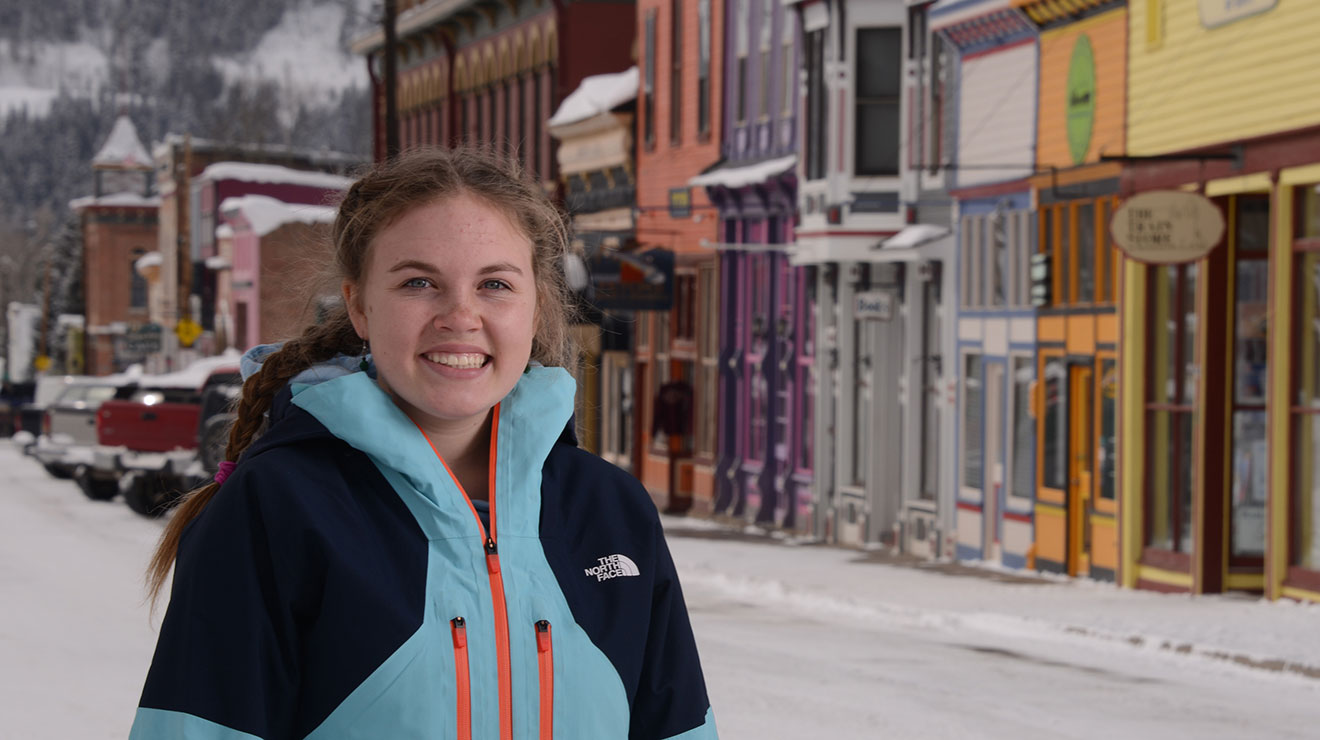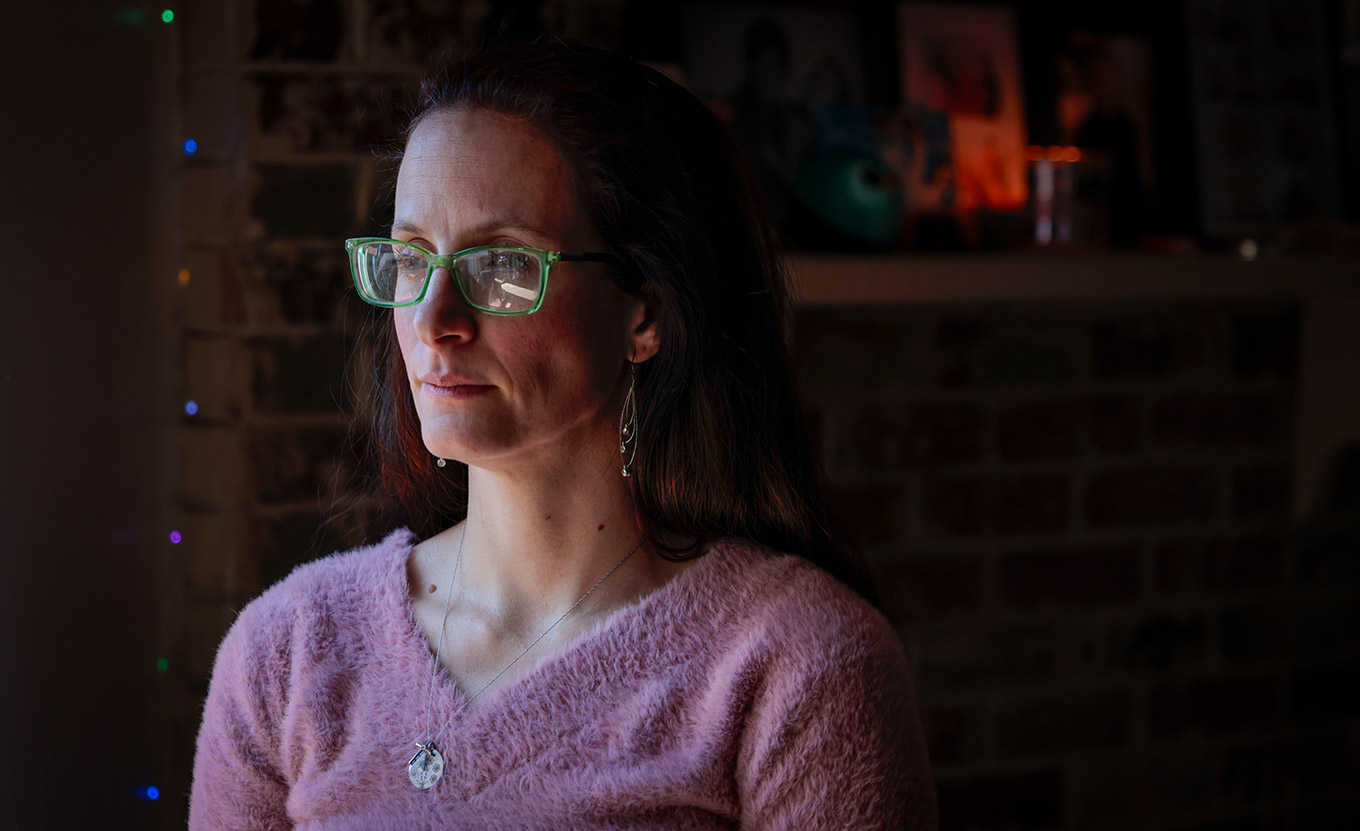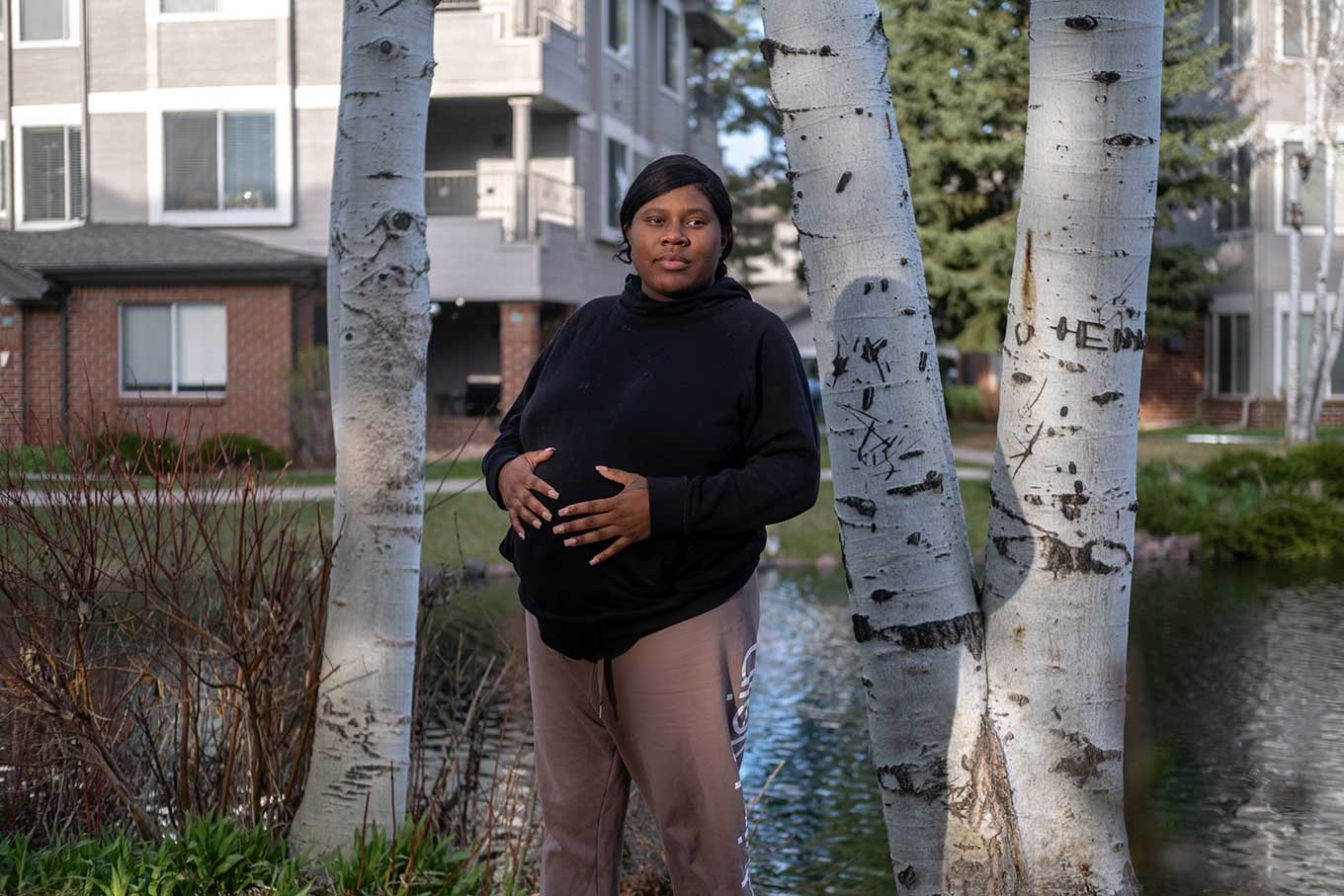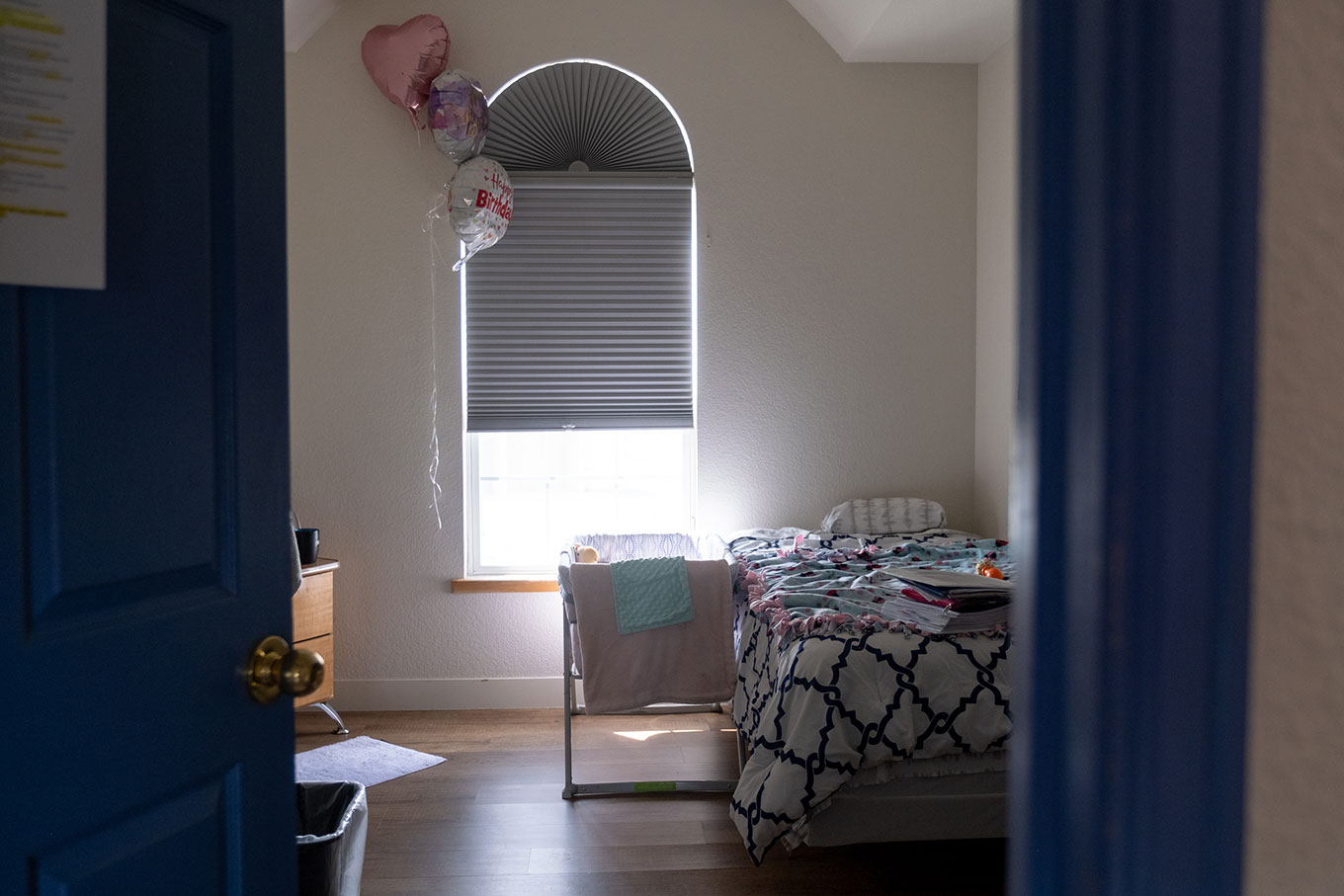
Belen Roof, a 15-year-old from Silverton, says she has seen e-cigarette vaping surge in popularity among fellow high school students in rural southwest Colorado. Photo by David Cornwell
Belen Roof, a 15-year-old from Silverton, says she has seen e-cigarette vaping surge in popularity among fellow high school students in rural southwest Colorado. Photo by David Cornwell
Belen Roof would seem to be fairly safe from the fast-spreading teenage practice of vaping that health officials call an epidemic.
Roof is a 15-year-old from Silverton, Colo. who loves to ski and play soccer. There will be six people in her graduating class at Silverton (“if no one moves,” Roof says); the beautifully rugged San Juan Mountains town is so small that everyone knows your good business and your bad business as soon as it happens.
But Roof, tucked away in the far southwestern corner of Colorado, has in fact seen the rush to vaping among her peers. Silverton is too small for a starting 11 for soccer, so she and others travel to Durango for practice and games. That’s when she noticed how many teenagers were trying the nicotine-based e-cigarettes, and how easy it was to hide the small devices from adults.
Roof, who has joined a tobacco-fighting group in Silverton backed by grants from the Colorado Department of Public Health and Environment (CDPHE), knows tobacco opponents have much educating and persuading to do in her age group.
“A lot of kids are like, ‘cigarettes are just disgusting,’ but then they’re vaping,” Roof said. “And I’m thinking, hmm, that doesn’t make any sense.”
High school students across Colorado are once again a primary target for the ongoing battle against nicotine products. Traditional cigarette use remains in public health officials’ eyes the deadliest preventable hazard to Americans’ health, and charts show it trending impressively downward among all groups for years. Still, the ebbing tide has uncovered lingering inequities in nicotine consumption and danger, as well as disparities in who is targeted in advertising and marketing for such products.
“The vaping epidemic has really stymied a lot of the progress we’ve made,” said Alison Reidmohr, tobacco communications specialist with CDPHE.
Anti-tobacco leaders are making a renewed push for regulation—pointing to startling vaping statistics—and employing new youth groups to make the case to peers and local government officials. The government levers they believe they can push harder include explicitly adding vaping and e-cigarettes to smoking bans, raising the purchase age of all tobacco and other nicotine products to 21, and banning flavored products that entice specific user groups and may speed addiction.
“If we added e-cigarettes into the no-tobacco areas here in Silverton, that would be really good,” Roof said, thinking it would make the message clearer to her peers that vaping is dangerous.
Beyond the disturbing popularity of vaping, recent in-depth surveys have shown high tobacco use in lower-income neighborhoods, among Medicaid patients, Indigenous people, LGBT youth and people with mental and behavioral health issues.
“We’ve made enormous progress overall in reducing smoking in the U.S, and that’s great news for public health, but there are large disparities in who still smokes,” said Vince Willmore, vice president of communications for the national Campaign for Tobacco Free Kids in Washington, D.C. “The progress has been uneven and the battle is definitely not over.”
Among Colorado youth, as larger anti-tobacco trends have remained positive, pockets of lingering disparity are capturing tobacco-fighters’ attention.
The Healthy Kids Colorado Survey, the most comprehensive measurement tool available for public health advocates, shows enormous success in discouraging traditional cigarette smoking. The percentage of Colorado youth who reported currently smoking cigarettes dropped from 11 percent in the 2013 survey to just 7 percent in the 2017 survey. That decline is sharper than the steady drops in adults reporting cigarette use in Colorado and nationwide.
Disparities public health advocates are trying to attack include much higher rates of cigarette smoking among youth identifying as gay, lesbian, bisexual or transgender. While 6 percent of self-identified heterosexual students said they were using cigarettes, the number rose to 17 percent for gay or lesbian students and 33 percent among transgender youth.
Vaping or e-cigarettes are the hottest problem. Colorado students are vaping nicotine products at twice the national average and at the highest level of the 37 states surveyed by the Centers for Disease Control and Prevention in 2018. Twenty-seven percent of high school students in Colorado said they were currently vaping.
Public health advocates see one of their opportunities in another striking statistic from the surveys—while 87 percent of Colorado high school students say cigarette smoking is risky, meaning past public-health messages have worked, only 50 percent say the same about vaping nicotine.
Research has found that nicotine negatively impacts brain development in teens, and can lead to concentration issues in school. Nicotine aside, vape clouds can contain numerous metals, chemicals and toxins already associated with health problems. And other research has found vaping quadruples the risk of 12th graders taking up cigarette smoking.
Drilling into the statistics on adults also reveals challenge and opportunity for anti-tobacco groups.
Colorado paced the continuing national decline in cigarette smoking, with 14.6 percent of adults in 2017 reporting they smoked compared to the national rate of 14 percent. Colorado public health officials have begun focusing on troublesome categories such as “straight to work” or non-college educated young adults, where 28 percent reported smoking in the most recent survey. More than 1 million Coloradans are now covered by Health First Colorado (Medicaid), and smoking rates are 34 percent in that group.
Smoking also persists at higher levels among lower-income Coloradans, with 22 percent reporting smoking if they earn less than 250 percent of the federal poverty level (or about $31,225 for an individual).
Researchers have pointed out that tobacco company marketing can contribute to the disparities, with methods including placement of cigarette discount coupons with food stamps. Colorado tobacco opponents have also pointed out that tobacco companies targeted LGBT communities by becoming early sponsors of publications and events aimed at those groups. Additionally, some Colorado public health officials have long suspected that tobacco companies have historically used Colorado as a test market for their products, which could in part explain Colorado’s unfortunate top ranking for teenagers who report vaping.
The health impacts from those disparities are documented over and over again in the kind of place-based public health research that came to the fore in the past decade.
Researchers believe higher smoking rates are one contributor to a growing divide in cancer rates and other diseases in lower-income neighborhoods in American cities. In a Journal of the American Medical Association report on smoking by census tract, researchers found that in neighborhoods where smoking rates were in the 90th percentile, asthma rates rose by 39 percent over neighborhoods where smoking was in the 10th percentile. Among other conditions, chronic obstructive pulmonary disease rates rose by 120 percent and coronary heart disease by 27 percent.
Smoking and tobacco use “are major contributors to health disparities in our country,” Willmore said.
The new efforts to combat tobacco products in Colorado include a concentration on geography and a careful analysis of the demographic results available through ongoing surveys.
The state encourages local public health leaders to apply for community-specific grants from Amendment 35, the last time tobacco taxes were raised in Colorado in 2005. (A 2016 tobacco tax increase on the state ballot failed to pass.) Reidmohr mentioned a Weld County effort at a local food bank, offering free registration for the Colorado QuitLine with onsite enrollment volunteers. Rachel Freeman, a tobacco control specialist in the Weld County Department of Public Health and Environment, said the county is using a state grant from July 2018 for a deep data dive and other initiatives.
Freeman’s team learned that while tobacco use overall in Weld County is at about 17 percent of residents, Fort Lupton’s rate is 30 percent. “That was pretty staggering,” Freeman said.
A deeper look at Fort Lupton demographics found 1 in 3 residents had not graduated from high school, 4 in 10 live below federal poverty levels, and median income is lower than in the rest of the county.
Freeman’s team knows the dangers of walking into any community and declaring, in effect, “you’re behind and you need help.”
“We weren’t sure how we’d be perceived,” she said. “We love our evidence base and our assessments, but there’s a point you have to recognize the humanity of the situation and that we are coming in as outsiders and need to go listen.”
The Weld County team is working hard, Freeman said, to talk to a wide range of community members from many socio-economic groups, while also seeking input from the mayor, school board and other community leaders. In April, the team will host a public meeting to present all the data, “for community members to look at and interact, and continue the conversation.”
Heather Kennedy is passionate about taking that same tobacco fight to local levels through youth groups and social justice discussions.
Kennedy, a technical assistance provider at the Center for Public Health Practice at the Colorado School of Public Health, believes the next level of tobacco fighting needs to look at tobacco use as “a symptom of a problem instead of just the actual problem.”
Look at the groups the statistics point to in Colorado, Kennedy urges: LGBT youth, lower-income neighborhoods, kids who report experiencing discrimination. “You see the upstream causes,” Kennedy said. “So how can we create changes upstream that not only get at tobacco use, but also can improve young peoples’ lives?”
Kennedy and others proposed a youth coalition called UpRISE, employing a $1.8 million state grant and seeking representatives for youth-run councils across the state. UpRISE (Resist, Inform, Step-up, Empower) is now operating in 21 communities, from Belen Roof’s San Juan County in the southwest through the Denver metro area and Las Animas, Logan and Moffat counties in rural Colorado.
Roof’s youth group is just getting started, doing their own research and absorbing the social justice-based curriculum from UpRISE on societal power systems and the tobacco industry. She agrees the anti-vaping work will be more effective through a youth-centered board. “If it comes from a kid, it will be more powerful; if something comes from an adult, they want to rebel, but if a bunch of kids are saying something, they might respect it more,” she said.
One first order of policy work might be seeking a vaping ban in Silverton’s open space parks, similar to an existing ban on smoking. That would help drive home the message that nicotine addiction from vaping can be just as dangerous as burning tobacco, Roof said.
Khalid Shahba is a 16-year-old junior at Poudre High School in Fort Collins, and a member of Youth Action for Health in Larimer County. He’s spent time in Egypt with his family and seen tobacco companies conducting exploitative marketing there, and now he’s disturbed by vape marketing in the U.S.
“I’ve seen super-easy accessibility for vape products, like legal seniors selling it to younger kids in high school,” said Shahba, a soccer player. “Some even are sold with pens in the bottom—the market is training you to be secretive about it, as if they know what they are doing is illegal. It’s not morally or ethically right for kids to be exploited like that.”
Colorado youth surveys have shown 40 percent of kids saying they bought their vape products for themselves, online or through a convenience store that should have asked for 18-year-old ID.
The Larimer youth group is working on designs and costs for a youth-focused counseling and addiction center, Shahba said.
For tobacco policy activists, the “gold standard” continues to be raising prices of tobacco products, which has consistently proven to reduce use, Reidmohr said. A similar effect is now appearing among non-tobacco nicotine products as well: Reidmohr cited a 2016 Surgeon General’s report that “a 10 percent increase in the price of e-cigarettes has been estimated to reduce sales of disposable e-cigarettes by approximately 12 percent and reusable products by about 19 percent.” Youth are particularly sensitive to price increases; a 10 percent rise in cigarette prices can lead to a 5 to 15 percent drop in youth usage, a federal report concluded.
Since Colorado’s 2016 ballot issue on a tax increase failed, policy efforts have focused on raising the age for tobacco purchases from 18, and creating a licensing system for tobacco retailers that would make enforcement of age laws easier. (In Colorado, you need a license to cut hair at a salon, but not to sell tobacco at a retail outlet.) Currently, the FDA and state Department of Revenue have limited resources to send age-checkers out to retailers, and fines are too low to act as a deterrent, Reidmohr said.
Locally, Aspen passed a licensing and tax boost in 2017, and the city council raised the purchase age to 21. Yet one challenge in getting local communities to take on new tobacco restrictions, such as licensing tobacco retailers, is “local preemption.” Under current state law, local communities with more restrictive rules lose their share of Amendment 35 taxes, Reidmohr said. Aspen’s local tobacco tax boost was designed to fill that revenue hole. The state legislature this year is considering a revision that would eliminate that penalty.
On the national level, anti-tobacco activists want the FDA to carry through on recent warnings that it’s interested in banning flavored nicotine products—including menthol cigarettes and vaping products with flavors like watermelon and mango—as well as limit nicotine to non-addictive levels. Studies have shown menthol cigarette marketing has frequently targeted African-American communities, while the candy-flavored vapes have been a big lure in the illicit youth market.
FDA director Scott Gottlieb, MD at a January hearing made an “existential” threat to e-cigarette makers, saying they would face draconian regulation if they didn’t stop all marketing that attracts children or failed to tighten online purchase systems.
“These are game-changing proposals that can really accelerate declines in smoking and address disparities in people who still smoke,” said Willmore of the Campaign for Tobacco Free Kids.


